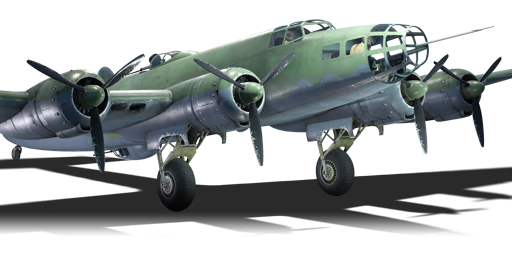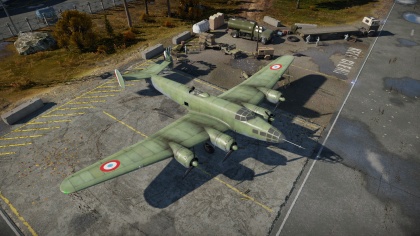Difference between revisions of "M.B.162"
(Features (Comat flap, Take-off flap, Landing flap)) (Tag: Visual edit) |
(Edits.) |
||
| Line 224: | Line 224: | ||
<!--Describe the history of the creation and combat usage of the aircraft in more detail than in the introduction. If the historical reference turns out to be too long, take it to a separate article, taking a link to the article about the vehicle and adding a block "/ History" (example: <nowiki>https://wiki.warthunder.com/(Vehicle-name)/History</nowiki>) and add a link to it here using the <code>main</code> template. Be sure to reference text and sources by using <code><nowiki><ref></nowiki></code>, as well as adding them at the end of the article. This section may also include the vehicle's dev blog entry (if applicable) and the in-game encyclopedia description (under <code><nowiki>=== Encyclopedia Info ===</nowiki></code>, also if applicable).--> | <!--Describe the history of the creation and combat usage of the aircraft in more detail than in the introduction. If the historical reference turns out to be too long, take it to a separate article, taking a link to the article about the vehicle and adding a block "/ History" (example: <nowiki>https://wiki.warthunder.com/(Vehicle-name)/History</nowiki>) and add a link to it here using the <code>main</code> template. Be sure to reference text and sources by using <code><nowiki><ref></nowiki></code>, as well as adding them at the end of the article. This section may also include the vehicle's dev blog entry (if applicable) and the in-game encyclopedia description (under <code><nowiki>=== Encyclopedia Info ===</nowiki></code>, also if applicable).--> | ||
| − | The M.B.162 was derived from the original civilian airliner Bloch M.B. 160 already in service and was built as mail plane by the Société des Avions Marcel Bloch. '''Société des Avions Marcel Bloch''' was a French aircraft manufacturer of both military and civilian aircraft which changed its name to Dassault Aviation after the end of World War II. The company was originally founded by Marcel Bloch (hence "MB" in the aircraft designations) who, after the war changed his name to Marcel Dassault | + | The M.B.162 was derived from the original civilian airliner Bloch M.B. 160 already in service and was built as mail plane by the Société des Avions Marcel Bloch. '''Société des Avions Marcel Bloch''' was a French aircraft manufacturer of both military and civilian aircraft which changed its name to Dassault Aviation after the end of World War II. The company was originally founded by Marcel Bloch (hence "MB" in the aircraft designations) who, after the war changed his name to Marcel Dassault, the Bloch M.B. 162 shares very few common points with his civilian counterpart, especially concerning its wings<ref name="dassault01" /> |
| − | The aircraft in game represents a heavy bomber created by Henri Déplante and Lucien Servanty in order to satisfy the A20 program concerning a category B5 bomber, which had a crew of 5 persons utilised for both day and night bombing. Three M.B.162s were ordered into production in 1937. | + | The aircraft in-game represents a heavy bomber created by Henri Déplante and Lucien Servanty in order to satisfy the A20 program concerning a category B5 bomber, which had a crew of 5 persons utilised for both day and night bombing. Three M.B.162s were ordered into production in 1937. |
| − | Unfortunately, the first flight of the M.B.162 wasn't until the 1st of June 1940<ref | + | Unfortunately, the first flight of the M.B.162 wasn't until the 1st of June 1940 <ref name="dassault02" /> and it never saw combat during the Battle of France (10 May to 25 June 1940). With the fall of France, the prototype of the M.B.162 fell into the Luftwaffe's hands and was used as transport aircraft for the rest of the ware. After the war, the aircraft was returned to the French who utilised it in the Armée de l'Air and became the origin of the SNCASE Languedoc (post-war airliner, used for hypersonic experimentations). |
Two versions of this plane existed: the MB.162.01 (prototype, one built) and the MB.162 Bn.5 (Production model, never produced). | Two versions of this plane existed: the MB.162.01 (prototype, one built) and the MB.162 Bn.5 (Production model, never produced). | ||
| Line 257: | Line 257: | ||
{{France bombers}} | {{France bombers}} | ||
| − | <references /> | + | <references> |
| + | <ref name="dassault01">https://www.dassault-aviation.com/fr/passion/avions/bloch-militaires/mb-162/# L’avion [MB 161], de taille légèrement inférieure et de performances comparable au B-17, ne possède que très peu d’éléments en commun avec les MB 160 et MB 161, son aile, notamment, est très différente.</ref> | ||
| + | <ref name="dassault02">https://www.dassault-aviation.com/fr/passion/avions/bloch-militaires/mb-162/# La construction du prototype à Courbevoie est retardée jusqu’à la fin de 1939. Assemblé à Villacoublay après son transfert par route au printemps 1940, il effectue son premier vol le 1er juin 1940 équipé de quatre Gnôme et Rhône14 N 48/49de 1100 ch.</ref> | ||
| + | </references> | ||
Revision as of 11:38, 21 November 2019
Contents
Description
The M.B.162 is a rank III French frontline bombers
with a battle rating of 4.0 (AB/SB) and 5.0 (RB). It was introduced in Update 1.73 "Vive la France".
General info
Flight Performance
Describe how the aircraft behaves in the air. Speed, manoeuvrability, acceleration and allowable loads - these are the most important characteristics of the vehicle.
| Characteristics | |||||||
|---|---|---|---|---|---|---|---|
| Stock | |||||||
| Max Speed (km/h at ?,000 m) |
Max altitude (meters) |
Turn time (seconds) |
Rate of climb (meters/second) |
Take-off run (meters) | |||
| AB | RB | AB | RB | AB | RB | ||
| 508 | 497 | 10,300 | 27,8 | 28,3 | 8,5 | 8,5 | 650 |
| Upgraded | |||||||
| Max Speed (km/h at ?,000 m) |
Max altitude (meters) | Turn time (seconds) | Rate of climb (meters/second) |
Take-off run (meters) | |||
| AB | RB | AB | RB | AB | RB | ||
| 571 | 537 | 13,300 | 26,7 | 27,0 | 16,2 | 11,6 | 650 |
Details
| Features | ||||
|---|---|---|---|---|
| Combat flap | Take-off flap | Landing flap | Air brakes | Arrestor gear |
| ✓ | ✓ | ✓ | X | X |
| Limits | ||||
|---|---|---|---|---|
| Wing-break speed (km/h) |
Gear limit (km/h) |
Combat flap (km/h) |
Max Static G | |
| + | - | |||
| ??? | ??? | ??? | ~?? | ~? |
| Optimal velocities | |||
|---|---|---|---|
| Ailerons (km/h) |
Rudder (km/h) |
Elevators (km/h) |
Radiator (km/h) |
| < ??? | < ??? | < ??? | > ??? |
| Compressor (RB/SB) | ||
|---|---|---|
| Setting 1 | ||
| Optimal altitude | 100% Engine power | WEP Engine power |
| ?,??? m | ??? hp | ?,??? hp |
Survivability and armour
- No armour plating
- Six total self-sealing fuel tanks located in wings
Armaments
Suspended armament
The M.B.162 can be configured with the following payloads:
- 6 x 100 kg №.1 bombs + 6 x 200 kg №.1 bombs (1,800 kg = total)
- 4 x 500 kg №.2 bombs (2,000 kg = total)
Defensive armament
The M.B.162 is armed with:
- 1 x 20 mm Hispano 404 cannon, dorsal turret (120 RPG)
- 1 x 20 mm Hispano 404 cannon, ventral turret (120 RPG)
- 1 x 7.5 mm MAC 1934 machine gun, 2 x beam turrets (500 RPG = 1,000 total)
Usage in battles
The M.B. 162 is a heavy bomber, and therefore should be flown as such. When you start a match, you will want to climb to 5-6 km in altitude, to protect yourself from German fighters that will climb to intercept you, and mark out a bomb target to your team. With both of the payload options, all bombs are needed to destroy a bombing base.
Manual Engine Control
| MEC elements | ||||||
|---|---|---|---|---|---|---|
| Mixer | Pitch | Radiator | Supercharger | Turbocharger | ||
| Oil | Water | Type | ||||
| Not controllable | Controllable Automatic pitch |
Controllable | Not controllable | Combined | Controllable | Not controllable |
Modules
| Tier | Flight performance | Survivability | Weaponry |
|---|---|---|---|
| IA | |||
| II | |||
| III | |||
| IV |
Pros and cons
Pros:
- Powerful Hispano 404 cannons in dorsal and ventral turrets
- Effective bomb payload
- Respectable speed for a heavy bomber
- Good max altitude
Cons:
- Turrets cannot turn 360 degrees
- HS.404 cannons have low ammunition count
- No turrets protecting the front, perpendicular sides, or directly vertical
History
The M.B.162 was derived from the original civilian airliner Bloch M.B. 160 already in service and was built as mail plane by the Société des Avions Marcel Bloch. Société des Avions Marcel Bloch was a French aircraft manufacturer of both military and civilian aircraft which changed its name to Dassault Aviation after the end of World War II. The company was originally founded by Marcel Bloch (hence "MB" in the aircraft designations) who, after the war changed his name to Marcel Dassault, the Bloch M.B. 162 shares very few common points with his civilian counterpart, especially concerning its wings[1]
The aircraft in-game represents a heavy bomber created by Henri Déplante and Lucien Servanty in order to satisfy the A20 program concerning a category B5 bomber, which had a crew of 5 persons utilised for both day and night bombing. Three M.B.162s were ordered into production in 1937.
Unfortunately, the first flight of the M.B.162 wasn't until the 1st of June 1940 [2] and it never saw combat during the Battle of France (10 May to 25 June 1940). With the fall of France, the prototype of the M.B.162 fell into the Luftwaffe's hands and was used as transport aircraft for the rest of the ware. After the war, the aircraft was returned to the French who utilised it in the Armée de l'Air and became the origin of the SNCASE Languedoc (post-war airliner, used for hypersonic experimentations).
Two versions of this plane existed: the MB.162.01 (prototype, one built) and the MB.162 Bn.5 (Production model, never produced).
Media
Excellent additions to the article would be video guides, screenshots from the game, and photos.
Camouflages :
- French camouflage of the M.B. 162 by Vaxioss [Semi-Historical]
- German Camouflage of the captured M.B.162 by MrSpacemau5 [Semi-Historical]
See also
Links to the articles on the War Thunder Wiki that you think will be useful for the reader, for example:
- reference to the series of the aircraft;
- links to approximate analogues of other nations and research trees.
External links
- Dassault Aviation official page concerning the aircraft
- [Wikipedia] Bloch MB.162
| France bombers | |
|---|---|
| Farman | F.222.2 · N.C.223.3 |
| Latécoère | Late 298D |
| Potez | Potez 633 |
| Liore et Olivier | LeO 451 early · LeO 451 late |
| Bloch | M.B.174A-3 · M.B.162 · M.B.175T |
| American | V-156-F · Martin 167-A3 · ▄A-35B · ▄SB2C-5 · B-26C · ▄PBY-5A Late · ▄PB4Y-2 |
| British | Lancaster MR.7 |
- ↑ https://www.dassault-aviation.com/fr/passion/avions/bloch-militaires/mb-162/# L’avion [MB 161], de taille légèrement inférieure et de performances comparable au B-17, ne possède que très peu d’éléments en commun avec les MB 160 et MB 161, son aile, notamment, est très différente.
- ↑ https://www.dassault-aviation.com/fr/passion/avions/bloch-militaires/mb-162/# La construction du prototype à Courbevoie est retardée jusqu’à la fin de 1939. Assemblé à Villacoublay après son transfert par route au printemps 1940, il effectue son premier vol le 1er juin 1940 équipé de quatre Gnôme et Rhône14 N 48/49de 1100 ch.





